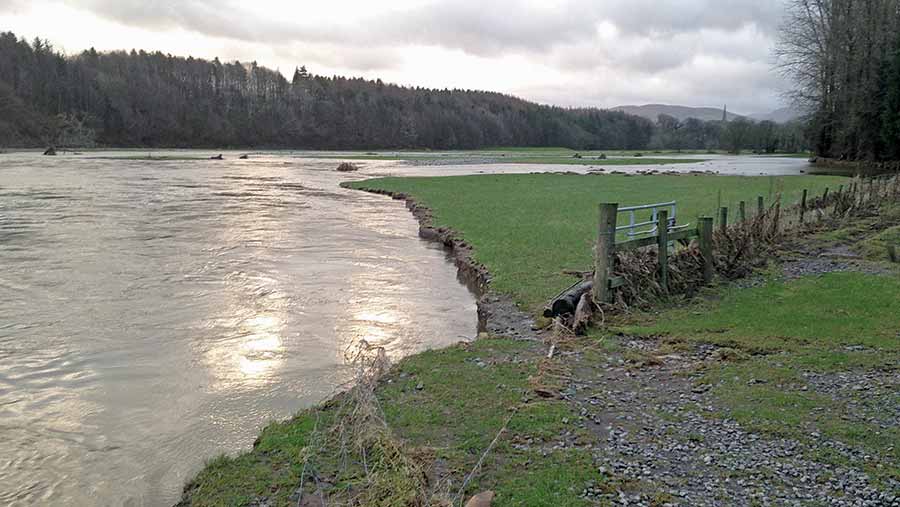Farmers count the cost of flood misery
 ©Andrew Ward
©Andrew Ward Storm and flood damage in the north of England and Scotland has left individual farm businesses facing losses running into tens of thousands of pounds – and many farmers with a clean-up operation that could take years.
Farm organisations report the true scale of the damage across Cumbria, Lancashire, Yorkshire, Scotland and north Wales is yet to become clear, with farmers concentrating their efforts on dealing with the immediate problems they face.
NFU Mutual estimates the costs of claims it will deal with could be as much as £40m. However, the final cost to the industry is likely to be much higher as farmers will be dealing with many incidents for which they would not be insured.
See also: Wet weather raises slurry storage concerns
Farmers suffering from uninsurable losses can apply for a grant of up to £20,000 from the Farming Recovery Fund, which the government had extended to cover farmers in Lancashire and Yorkshire, as well as Cumbria and Northumberland.
However, producers will need to meet the strict criteria before they can make an application.
Aberdeenshire
David Winton, who farms 60ha at Haughs of Birse near Aboyne, said as the floodwater rose on 30 December it was like being in the middle of a disaster movie.
“We have 6ha that floods pretty regularly – that flooded at about 10am. But from 1pm-3pm it was as if someone had turned the tap on and we went from having 6ha to 40ha under water.”
Mr Winton said he had already moved his sheep to higher ground and his cattle were inside, but the speed at which the water rose took everyone by surprise.
Four cows and a bull from his neighbour’s farm were washed down to his farm, while he himself lost seven tups, two-and-half miles of fencing and has seen more than 1ha of ground completely washed away by the river. Another 6ha has been left covered by a sea of shingle and rocks.
“We’ll never get the land back that has been washed away and the shingle won’t be put right this year. It could take three or even five years to recover. It has never been so bad here before and my grandfather came here in 1942. However, there are people nearer to Aberdeen who have had it even worse.”

Gravel dumped on a field near the river Derwent, between Cockermouth and Workington. Photo taken by Andrew Ward.
West Yorkshire
In West Yorkshire, Willow Grove Farm near Castleford has been left surrounded by water on two sides after the River Calder breached a flood wall that runs in front of the property.
Graham Wright said his father, who runs the business, had been forced to evacuate his pig herd to neighbouring farms and move into a caravan because there was no power in the house.
The land under water was not part of the farm, but the water was so close to the house that it was seeping into the cellar. “It has been like that since Boxing Day and there is no electricity in the house.”
Mr Wright acknowledged the ground was a floodplain, but said there was no way for the water to escape since a siphon pipe had been blocked up with concrete some years ago.
“We daren’t move the livestock back to the farm until the water goes down. We can’t cope any more. We need the siphon put back in and then a bund around the front of the property.”
North Yorkshire
Richard Bramley, who farms at Kelfield, south of York, still has 72ha out of his 200ha under water 10 days after water topped the flood bank next to the River Ouse.
Mr Bramley said while he expected the ground to be flooded from time to time, this is the eighth time since 2000 the land has been submerged.
The winter wheat and oilseed rape currently under about 12ft of silty water is expected to be a write-off because it has been starved off oxygen and light for so long, he said.
Mr Bramley urged the government to rethink its approach to managing water and flood risk.
“The issue we have is the speed and quantity of water that comes off the higher ground. We are getting more rainfall, more often and the speed it comes off the hills is quite staggering.
“We can end up spending millions of pounds on civil engineering projects to protect cities or we can start to manage the flow of water better. If we [as a farm] need to store water, then we need to be properly compensated.”
Forage Aid
Forage Aid founder Andrew Ward said to date demand for forage in the flood-hit areas had been relatively low, because while many people had lost some fodder, most had something left, which they were using before it spoiled.
The charity had already moved 150-170t of straw, hay, silage and haylage up to the north-west of England, but the bulk of that was being stored until more requests started to come through.
Mr Ward said he had visited Cumbria before Christmas and had seen the devastation the floods had caused, with some fields covered in up to 2ft of boulders, rocks and shale.
“The grazing available to farmers is going to be restricted. But we have had a massive response in terms of farmers coming forward offering donations of fodder, time or haulage. We’ve probably had about 370 different offers for straw and produce through the Forage Aid website already (www.forageaid.org.uk).”
